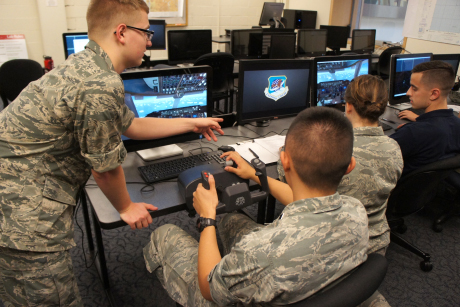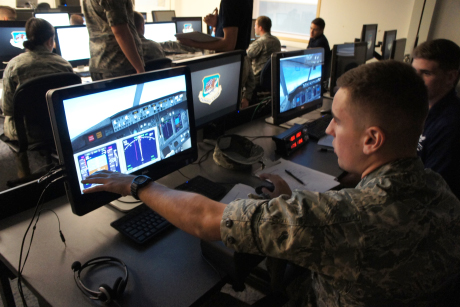Mission Big Red Flag: Simulated flight, real sweat
By H. Roger Segelken


So you wanna fly Air Force One?
Not a problem – just some adrenalin-pumping, brow-sweat-popping challenges on the Big Red Flag mission to Beirut International Airport, where POTUS (the President of the United States) needs to meet other leaders about the security threat from ISIS terrorists.
Of course you’ll want to enroll in AIRS 1141/1142, Leadership Laboratory. The 20 Air Force cadets filing into the Phillips Hall computer lab this October afternoon are all in the Reserve Officer Training Corps.
Don’t expect a rerun of the Harrison Ford thriller, “Air Force One.” This will be much more realistic – thanks to computer programming by Cadet Scott Seidenberger ’16. The ILR School junior adapted off-the-shelf flight-simulator software to accommodate intelligence analysts, air traffic controllers, air battle managers, pilots for Air Force One and military escorts, Predator drone jockeys, navigators and weapons systems operators.
The role of POTUS is played by Air Force Capt. Kevin O’Brien, head instructor of the leadership lab. Your mission: try to keep him – and the plane – out of enemy hands. In the dimly lit back of Phillips 318, two costumed characters hunch over their own set of flight controls.
As the simulated jet engines spool up and Cadet Sam Lee prepares for takeoff, Seidenberger thanks Cornell Information Technology specialists: “They were able to splash my highly modified programs to all the workstations in this lab, to put our cadets in a realistic environment.”
Takeoff is uneventful. Changes in altitude and bearing are becoming almost routine.
The rules of engagement, recited earlier, are almost forgotten (“If hostile aircraft penetrate our restricted air zone …”) when a “bogey” streaks across the screen. An unidentified something is closing – fast – on Air Fore One.
“They haven’t even looked back here yet,” says Cadet Samuel Tome ’16, guiding the bogey, a simulated Learjet, while a ragged disguise tops Army fatigues worn by the Engineering junior.
“We’re the bad guys,” reveals Cadet Eva Garrido, a College of Arts and Sciences sophomore. “Our mission is to fly a civilian plane toward their formation and see how they react. We’re both Army ROTC.”
There’s a friendly rivalry between the military services at Cornell, Tome confides: “We take every opportunity to heckle our Air Force brethren.”
Unheckled and hardly terrorized, the Air Force contingent handles the situation. No missiles are fired. The F-35 fighter escort persuades the intruder to move aside. Radar shows the Learjet veering off, descending – and landing at the same airport where Air Force One will set down.
Then the autopilot fails completely. Steady (if clammy) human hands take over the controls and guide the giant aircraft to a bumpy, simulated landing.
POTUS releases a white-knuckled death grip on the table edge. He has a problem with the terrorist-flown plane awaiting his arrival. “If you think something’s wrong, be passionate about it,” O’Brien says. “Speak up. Fight for what you believe in. “
Maybe this is the time to raise your hand and venture, “It was crazy up there, and that’s when we should have freaked. But we didn’t. In all the craziness and stress, we stayed calm, rational and we got it done.”
Seidenberger agrees. This exercise, he says, “was about each of you knowing your job and how it interacts with the larger mission.”
No longer POTUS – not even gruff Harrison Ford – O’Brien has the penultimate word: “You guys did a great job. Thank you for taking this seriously, for having a sense of urgency, because training is only as good as you make it for yourselves.”
And the last word, too: “Let’s head back to Barton for p.t. (physical training) time.”
That fresh, crisp air will feel awfully good.
Media Contact
Get Cornell news delivered right to your inbox.
Subscribe